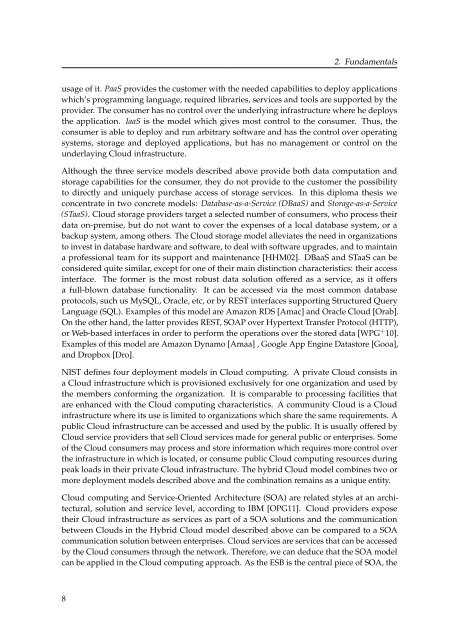Diploma Thesis Santiago Gómez Sáez - IAAS
Diploma Thesis Santiago Gómez Sáez - IAAS
Diploma Thesis Santiago Gómez Sáez - IAAS
You also want an ePaper? Increase the reach of your titles
YUMPU automatically turns print PDFs into web optimized ePapers that Google loves.
2. Fundamentals<br />
usage of it. PaaS provides the customer with the needed capabilities to deploy applications<br />
which’s programming language, required libraries, services and tools are supported by the<br />
provider. The consumer has no control over the underlying infrastructure where he deploys<br />
the application. IaaS is the model which gives most control to the consumer. Thus, the<br />
consumer is able to deploy and run arbitrary software and has the control over operating<br />
systems, storage and deployed applications, but has no management or control on the<br />
underlaying Cloud infrastructure.<br />
Although the three service models described above provide both data computation and<br />
storage capabilities for the consumer, they do not provide to the customer the possibility<br />
to directly and uniquely purchase access of storage services. In this diploma thesis we<br />
concentrate in two concrete models: Database-as-a-Service (DBaaS) and Storage-as-a-Service<br />
(STaaS). Cloud storage providers target a selected number of consumers, who process their<br />
data on-premise, but do not want to cover the expenses of a local database system, or a<br />
backup system, among others. The Cloud storage model alleviates the need in organizations<br />
to invest in database hardware and software, to deal with software upgrades, and to maintain<br />
a professional team for its support and maintenance [HHM02]. DBaaS and STaaS can be<br />
considered quite similar, except for one of their main distinction characteristics: their access<br />
interface. The former is the most robust data solution offered as a service, as it offers<br />
a full-blown database functionality. It can be accessed via the most common database<br />
protocols, such us MySQL, Oracle, etc, or by REST interfaces supporting Structured Query<br />
Language (SQL). Examples of this model are Amazon RDS [Amac] and Oracle Cloud [Orab].<br />
On the other hand, the latter provides REST, SOAP over Hypertext Transfer Protocol (HTTP),<br />
or Web-based interfaces in order to perform the operations over the stored data [WPG + 10].<br />
Examples of this model are Amazon Dynamo [Amaa] , Google App Engine Datastore [Gooa],<br />
and Dropbox [Dro].<br />
NIST defines four deployment models in Cloud computing. A private Cloud consists in<br />
a Cloud infrastructure which is provisioned exclusively for one organization and used by<br />
the members conforming the organization. It is comparable to processing facilities that<br />
are enhanced with the Cloud computing characteristics. A community Cloud is a Cloud<br />
infrastructure where its use is limited to organizations which share the same requirements. A<br />
public Cloud infrastructure can be accessed and used by the public. It is usually offered by<br />
Cloud service providers that sell Cloud services made for general public or enterprises. Some<br />
of the Cloud consumers may process and store information which requires more control over<br />
the infrastructure in which is located, or consume public Cloud computing resources during<br />
peak loads in their private Cloud infrastructure. The hybrid Cloud model combines two or<br />
more deployment models described above and the combination remains as a unique entity.<br />
Cloud computing and Service-Oriented Architecture (SOA) are related styles at an architectural,<br />
solution and service level, according to IBM [OPG11]. Cloud providers expose<br />
their Cloud infrastructure as services as part of a SOA solutions and the communication<br />
between Clouds in the Hybrid Cloud model described above can be compared to a SOA<br />
communication solution between enterprises. Cloud services are services that can be accessed<br />
by the Cloud consumers through the network. Therefore, we can deduce that the SOA model<br />
can be applied in the Cloud computing approach. As the ESB is the central piece of SOA, the<br />
8

















